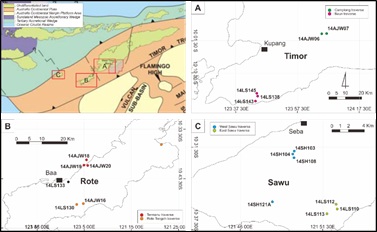Calcareous Nanofossil of Post-Gondwana Sequence in Southern Banda Arc, Indonesia
DOI:
https://doi.org/10.25299/jgeet.2021.6.2.6287Keywords:
Calcareous Nannofossil, Kolbano Sequence, Banda ArcAbstract
The presence of calcareous nannofossils in samples of the Post-Gondwana sequences (Kolbano and Viqueque sequence) gives guidance about the relative age of the study area located in the Outer Banda Arc, namely Timor, Rote, and Sawu Island. The study was carried out on six traverses, Timor Island traverse (Baun and Camplong), Rote Island traverse (Termanu and Central Rote), and Sawu Island traverses (West Sawu and East Sawu). There is 29 outcrop sample prepared using the smear slide method and observed using a polarizing microscope with 1000x magnification. The results of the study showed the presence of Cretaceous, Paleogene, and Neogen-Quarternary calcareous nannofossil. There are 82 species from 14 families identified in the post-Gondwana sequence. The results showed that the assemblage of calcareous nannofossil in Cretaceous characterized by the presence of Watznaueria fasciata, Watznaueria cynthae, Cyclagelosphaera brezae, Orastrum campanensis, and Micula concava. The assemblage of Paleogene calcareous nannofossil characterized by the presence of Coccolithus staurion, Chiasmolithus solitus, Discoaster minimus, Tawelus (?) magnicrassus, Chiasmolithus bidens, Prinsius africanus, Cyclicargolithus luminus, Spenolithus elongatus, Reticulofenestra umbilica, Cruciplacolithus vanheckae, and Helicospharea seminulum, and the assemblage of Neogene calcareous nannofossil characterized by the presence of Reticulofenestra pseudoumbilica, Discoaster quinqueramus, Helicosphaera princei, and Discoaster pansus. Quarternary calcareous nannofossil characterized by the presence of Ponthospaera indooceanica.
Downloads
References
Audley-Charles, M.G., 1968. The Geology of Portuguese TimoAudley-Charles, M. G. (1968): The Geology of Portuguese Timor, Geological Society London Memoirs.
Bak, K., 2007. Environmental Changes around the Cenomanian-Turonian Boundary in a Marginal Part of the Outer Carpathian Basin Expressed by Microfacies, Microfossils and Chemical Records in the Skole Nappe (Poland). Ann. Soc. Geol. Pol.
Barber, A.J., Audley-Charles, M.G., Carter, D.J., 1977. Thrust tectonics in timor. J. Geol. Soc. Aust.
Baumgartner, P.O., 1993. Early Cretaceous radiolarians of the Northeast Indian Ocean (Leg 123: Sites 765, 766 and DSDP Site 261): The Antarctic-Tethys connection. Mar. Micropaleontol.
Bown, P.R., Cooper, M.K.E., 1998. Jurassic, in: Calcareous Nannofossil Biostratigraphy.
Cai, Y., Hu, X., Li, X., Pan, Y., 2012. Origin of the red colour in a red limestone from the Vispi Quarry section (central Italy): A high-resolution transmission electron microscopy analysis. Cretac. Res.
Cai, Y., Li, X., Hu, X., Chen, X., Pan, Y., 2009. Paleoclimatic approach to the origin of the coloring of Turonian pelagic limestones from the Vispi Quarry section (Cretaceous, central Italy). Cretac. Res.
Cai, Y., Li, X., Pan, Y., Hu, X., 2008. The color-causing mechanism of Mn<sup>2+</sup> and Fe<sup>3+</sup>: Evidence from the Italian Cretaceous pelagic red limestones. Acta Geol. Sin.
Carter, D.J., Audley-Charles, M.G., Barber, A.J., 1976. Stratigraphical analysis of island arc-continental margin collision in eastern Indonesia. J. Geol. Soc. London.
De Wever, P., 1989. Radiolarians, Radiolarites, and Mesozoic Paleogeography of the Circum-Mediterranean Alpine Belts, in: Siliceous Deposits of the Tethys and Pacific Regions.
De Wever, P., Azema, J., Fourcade, E., 1994. Radiolaires et radiolarites: production primaire, diagenese et paleogeographie. Bull. - Centres Rech. Explor. Elf Aquitaine.
De Wever, P., O’Dogherty, L., Goričan, Š., 2014. Monsoon as a cause of radiolarite in the Tethyan realm. Comptes Rendus - Geosci.
Harris, R.A., Sawyer, R.K., Audley-Charles, M.G., 1998. Collisional melange development: geologic associations of active melange-forming processes with exhumed melange facies in the western Banda orogen, Indonesia. Tectonics.
Hu, X., Jansa, L., Wang, C., Sarti, M., Bak, K., Wagreich, M., Michalik, J., Soták, J., 2005. Upper Cretaceous oceanic red beds (CORBs) in the Tethys: Occurrences, lithofacies, age, and environments. Cretac. Res.
M.G, A.-C., 2004. Ocean trench blocked and obliterated by Banda forearc collision with Australian proximal continental slope. Tectonophysics.
Martini, E., 1970. Standard palaeogene calcareous nannoplankton zonation. Nature.
Sawyer, R.K., 2018. The stratigraphy and sedimentology of West Timor, Indonesia.
SCOTT, R.W., HU, X., WANG, C., WAGREICH, M., JANSA, L., 2009. Introduction to Cretaceous Oceanic Red Beds: Stratigraphy, Composition, Origins, and Paleoceanographic and Paleoclimatic Significance. Cretac. Ocean Redbeds 7–10.
Suwitodirjo, T., 1996. Peta Geologi Lembar Kupang – Atambua, Timor, Pusat Penelitian dan Pengembangan Geologi.
Villeneuve, M., Cornée, J.-J., Martini, R., Zaninetti, L., 2004. New hypothesis on the origin of the Timor Island formations (South East Asia) | Nouvelle hypothèse sur l’origine des formations géologiques de l’île de Timor (Sud-Est asiatique). Comptes Rendus - Geosci.

Downloads
Published
Issue
Section
License
Copyright @2019. This is an open-access article distributed under the terms of the Creative Commons Attribution-ShareAlike 4.0 International License which permits unrestricted use, distribution, and reproduction in any medium. Copyrights of all materials published in JGEET are freely available without charge to users or / institution. Users are allowed to read, download, copy, distribute, search, or link to full-text articles in this journal without asking by giving appropriate credit, provide a link to the license, and indicate if changes were made. All of the remix, transform, or build upon the material must distribute the contributions under the same license as the original.










